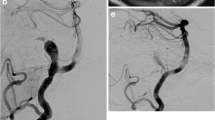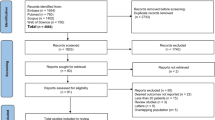Abstract
Flow diversion with the pipeline embolization device (PED) is increasingly used to treat intracranial aneurysms with high obliteration rates and low morbidity. However, long-term (≥ 1 year) angiographic and clinical outcomes still require further investigation. The aim of this study was to compare the occlusion and complication rates for small (< 10 mm) versus large (10–25 mm) aneurysms at long-term following treatment with PED. A systematic review and meta-analysis were performed in compliance with the Preferred Reporting Items for Systematic Reviews and Meta-Analyses. We conducted a comprehensive search of English language databases including Ovid MEDLINE and Epub Ahead of Print, In-Process, and Daily, Ovid EMBASE, Ovid Cochrane Central Register of Controlled Trials, Ovid Cochrane Database of Systematic Reviews, and Scopus. Our studies included a minimum of 10 patients treated with PED for small vs. large aneurysms and with at least 12 months of follow-up. The primary safety endpoint was the rate of clinical complications measured by the occurrence of symptomatic stroke (confirmed clinically and radiographically), intracranial hemorrhage, or aneurysmal rupture. The primary efficacy endpoint was the complete aneurysm occlusion rate. Our analysis included 19 studies with 1277 patients and 1493 aneurysms. Of those, 1378 aneurysms met our inclusion criteria. The mean age was 53.9 years, and most aneurysms were small (89.75%; N = 1340) in women (79.1%; N = 1010). The long-term occlusion rate was 73% (95%, CI 65 to 80%) in small compared to 84% (95%, CI 76 to 90%) in large aneurysms (p < 0.01). The symptomatic thromboembolic complication rate was 5% (95%, CI 3 to 9%) in small compared to 7% (95%, CI 4 to 13%) in large aneurysms (p = 0.01). The rupture rate was 2% vs. 4% (p = 0.92), and the rate of intracranial hemorrhage was 2% vs. 4% (p = 0.96) for small vs. large aneurysms, respectively; however, these differences were not statistically significant. The long-term occlusion rate after PED treatment is higher in large vs. small aneurysms. Symptomatic thromboembolic rates with stroke are also higher in large vs. small aneurysms. The difference in the rates of aneurysm rupture and intracranial hemorrhage was insignificant. Although the PED seems a safe and effective treatment for small and large aneurysms, further studies are required to clarify how occlusion rate and morbidity are affected by aneurysm size.



Similar content being viewed by others
Data availability
The datasets used originate from peer-reviewed publications available online.
References
Becske T et al (2013) Pipeline for uncoilable or failed aneurysms: results from a multicenter clinical trial. Radiology 267:858–868
Nelson PK et al (2011) The pipeline embolization device for the intracranial treatment of aneurysms trial. AJNR Am J Neuroradiol 32:34–40
Akinduro OO et al (2021) Pipeline embolization device for treatment of extracranial internal carotid artery pseudoaneurysms: a multicenter evaluation of safety and efficacy. Neurosurgery 89:S25–S25. Preprint at https://doi.org/10.1093/neuros/nyz548_s025
Cohen JE et al (2016) Vertebral artery pseudoaneurysms secondary to blunt trauma: endovascular management by means of neurostents and flow diverters. J Clin Neurosci 32:77–82
Brzezicki G, Rivet DJ, Reavey-Cantwell J (2016) Pipeline Embolization Device for treatment of high cervical and skull base carotid artery dissections: clinical case series. J Neurointerv Surg 8:722–728
Tsang AC-O, Leung K-M, Lee R, Lui W-M, Leung GK-K (2015) Primary endovascular treatment of post-irradiated carotid pseudoaneurysm at the skull base with the pipeline embolization device. J Neurointerv Surg 7:603–607
Hanel RA et al (2022) Prospective study on embolization of intracranial aneurysms with the pipeline device (PREMIER study): 3-year results with the application of a flow diverter specific occlusion classification. J Neurointerv Surg. https://doi.org/10.1136/neurintsurg-2021-018501
Adeeb N et al (2017) Treatment of tandem internal carotid artery aneurysms using a single pipeline embolization device: evaluation of safety and efficacy. AJNR Am J Neuroradiol 38:1605–1609
Amuluru K, Al-Mufti F, Romero CE (2021) Flow diversion treatment of anterior communicating artery region aneurysms. J Neuroradiol 48:391–396
Bhogal P, Ganslandt O, Bäzner H, Henkes H, Aguilar Perez M (2019) Treatment of unruptured, saccular, anterior choroidal artery aneurysms with flow diversion: a single centre experience. Clin Neuroradiol 29:459–465
Briganti F et al (2016) Flow diverter device for the treatment of small middle cerebral artery aneurysms. J Neurointerv Surg 8:287–294
Chalouhi N et al (2013) Comparison of flow diversion and coiling in large unruptured intracranial saccular aneurysms. Stroke 44:2150–2154
Chalouhi N et al (2017) Matched comparison of flow diversion and coiling in small, noncomplex intracranial aneurysms. Neurosurgery 81:92–97
Cruz JP et al (2013) Pipeline embolization device in aneurysmal subarachnoid hemorrhage. AJNR Am J Neuroradiol 34:271–276
Deng Q, Feng W, Hai H, Liu J (2018) Evaluation of the safety and efficacy of a pipeline flex embolization device for treatment of large, wide-necked intracranial aneurysms. J Interv Med 1:229–233
Diestro JDB et al (2021) Flow diversion for middle cerebral artery aneurysms: an international cohort study. Neurosurgery 89:1112–1121
Dmytriw AA et al (2022) The pipeline embolization device: a decade of lessons learned in the treatment of posterior circulation aneurysms in a multicenter cohort. J Neurosurg 137:1454–1461. Preprint at https://doi.org/10.3171/2021.12.jns212201
Feigen CM et al (2022) Pipeline embolization device and pipeline flex versus surpass streamline flow diversion in intracranial aneurysms: a retrospective propensity score-matched study. World Neurosurg 161:e384–e394
Griessenauer CJ et al (2016) Pipeline embolization device for small paraophthalmic artery aneurysms with an emphasis on the anatomical relationship of ophthalmic artery origin and aneurysm. J Neurosurg 125:1352–1359
Kole MJ et al (2019) Pipeline embolization device diameter is an important factor determining the efficacy of flow diversion treatment of small intracranial saccular aneurysms. J Neurointerv Surg 11:1004–1008
Lauzier DC et al (2022) The value of long-term angiographic follow-up following pipeline embolization of intracranial aneurysms. J Neurointerv Surg 14:585–588
Lee H et al (2021) Endovascular treatment of cavernous carotid artery aneurysms: a 10-year, single-center experience. Neuroradiol J 34:568–574
Li L et al (2022) Pipeline flex embolization device for the treatment of large unruptured posterior circulation aneurysms: single-center experience. J Clin Neurosci 96:127–132
Sweid A et al (2019) Safety and efficacy of bilateral flow diversion for treatment of anterior circulation cerebral aneurysms. World Neurosurg 130:e1116–e1121
Yoon JW et al (2014) Feasibility and safety of pipeline embolization device in patients with ruptured carotid blister aneurysms. Neurosurgery 75:419–29 (discussion 429)
Zhou Y, Wu X, Tian Z, Yang X, Mu S (2020) Pipeline embolization device with adjunctive coils for the treatment of unruptured large or giant vertebrobasilar aneurysms: a single-center experience. Front Neurol 11:522583
Rinkel GJ, Djibuti M, Algra A, van Gijn J (1998) Prevalence and risk of rupture of intracranial aneurysms: a systematic review. Stroke 29:251–256
From the American Association of Neurological Surgeons (AANS), American Society of Neuroradiology (ASNR), Cardiovascular and Interventional Radiology Society of Europe (CIRSE), Canadian Interventional Radiology Association (CIRA), Congress of Neurological Surgeons (CNS), European Society of Minimally Invasive Neurological Therapy (ESMINT), European Society of Neuroradiology (ESNR), European Stroke Organization (ESO), Society for Cardiovascular Angiography and Interventions (SCAI), Society of Interventional Radiology (SIR), Society of NeuroInterventional Surgery (SNIS), World Stroke Organization (WSO) et al (2018) Multisociety consensus quality improvement revised consensus statement for endovascular therapy of acute ischemic stroke. Int J Stroke 13:612–632
Chiu AHY et al (2015) Long-term follow-up results following elective treatment of unruptured intracranial aneurysms with the pipeline embolization device. AJNR Am J Neuroradiol 36:1728–1734
Gupta R et al (2018) Proposal of a follow-up imaging strategy following pipeline flow diversion treatment of intracranial aneurysms. J Neurosurg 131:32–39
Hanel RA, Monteiro A, Nelson PK, Lopes DK, Kallmes DF (2021) Predictors of incomplete aneurysm occlusion after treatment with the pipeline embolization device: PREMIER trial 1 year analysis. J Neurointerv Surg. https://doi.org/10.1136/neurintsurg-2021-018054
Sunohara T et al (2021) Neck location on the outer convexity is a predictor of incomplete occlusion in treatment with the pipeline embolization device: clinical and angiographic outcomes. AJNR Am J Neuroradiol 42:119–125
Becske T et al (2017) Long-term clinical and angiographic outcomes following pipeline embolization device treatment of complex internal carotid artery aneurysms: five-year results of the pipeline for uncoilable or failed aneurysms trial. Neurosurgery 80:40–48
Bender MT et al (2018) Predictors of cerebral aneurysm persistence and occlusion after flow diversion: a single-institution series of 445 cases with angiographic follow-up. J Neurosurg 130:259–267
Kallmes DF et al (2017) Safety and efficacy of the pipeline embolization device for treatment of intracranial aneurysms: a pooled analysis of 3 large studies. J Neurosurg 127:775–780
Adeeb N et al (2017) Pipeline embolization device in treatment of 50 unruptured large and giant aneurysms. World Neurosurg 105:232–237
Fujii T et al (2022) Long-term follow-up results after flow diverter therapy using the pipeline embolization device for large or giant unruptured internal carotid artery aneurysms: single-center retrospective analysis in the Japanese population. Neurol Med Chir 62:19–27
Brinjikji W, Murad MH, Lanzino G, Cloft HJ, Kallmes DF (2013) Endovascular treatment of intracranial aneurysms with flow diverters: a meta-analysis. Stroke 44:442–447
Suzuki R, Takigawa T, Nariai Y, Hyodo A, Suzuki K (2022) Comparison of pipeline embolization and coil embolization for the treatment of large unruptured paraclinoid aneurysms. Neurol Med Chir 62:97–104
Kim BM et al (2016) Pipeline embolization device for large/giant or fusiform aneurysms: an initial multi-center experience in Korea. Neurointervention 11:10–17
Saatci I, Yavuz K, Ozer C, Geyik S, Cekirge HS (2012) Treatment of intracranial aneurysms using the pipeline flow-diverter embolization device: a single-center experience with long-term follow-up results. AJNR Am J Neuroradiol 33:1436–1446
Adeeb N et al (2018) Risk of branch occlusion and ischemic complications with the pipeline embolization device in the treatment of posterior circulation aneurysms. AJNR Am J Neuroradiol 39:1303–1309
Lylyk I et al (2021) Pipeline embolization devices for the treatment of intracranial aneurysms, single-center registry: long-term angiographic and clinical outcomes from 1000 aneurysms. Neurosurgery 89:443–449
Kallmes DF et al (2016) Aneurysm study of pipeline in an observational registry (ASPIRe). Interv Neurol 5:89–99
Li Y-L, Roalfe A, Chu EY-L, Lee R, Tsang ACO (2021) Outcome of flow diverters with surface modifications in treatment of cerebral aneurysms: systematic review and meta-analysis. AJNR Am J Neuroradiol 42:327–333
Author information
Authors and Affiliations
Contributions
AKG: conception and design of the study, data collection, analysis, statistics, manuscript writing, critical manuscript review.
EG, JRZ, VGE, CPV, MG, SK: data collection, analysis, and interpretation, manuscript writing, critical manuscript review.
WCF, TJH, SSS, MO, AET, BRB, MB, RGT: conception and design of the study, critical manuscript review, and supervision of the work.
Corresponding author
Ethics declarations
Ethics approval
The need for ethical approval has been waved due to the de-identified nature of the data provided by the NIS database, as per the Mayo IRB.
Competing interests
The authors declare no competing interests.
Additional information
Publisher's Note
Springer Nature remains neutral with regard to jurisdictional claims in published maps and institutional affiliations.
Supplementary Information
Below is the link to the electronic supplementary material.
Rights and permissions
Springer Nature or its licensor (e.g. a society or other partner) holds exclusive rights to this article under a publishing agreement with the author(s) or other rightsholder(s); author self-archiving of the accepted manuscript version of this article is solely governed by the terms of such publishing agreement and applicable law.
About this article
Cite this article
Ghaith, A.K., Greco, E., Rios-Zermeno, J. et al. Safety and efficacy of the pipeline embolization device for treatment of small vs. large aneurysms: a systematic review and meta-analysis. Neurosurg Rev 46, 284 (2023). https://doi.org/10.1007/s10143-023-02192-0
Received:
Revised:
Accepted:
Published:
DOI: https://doi.org/10.1007/s10143-023-02192-0




